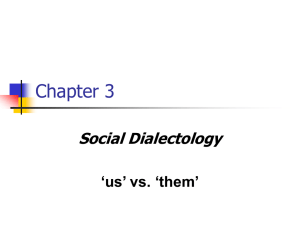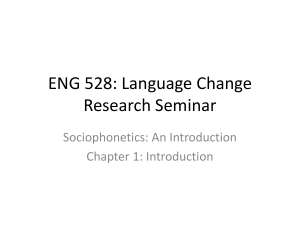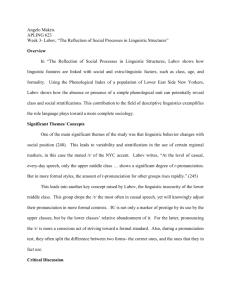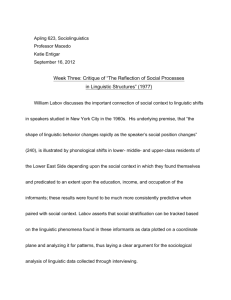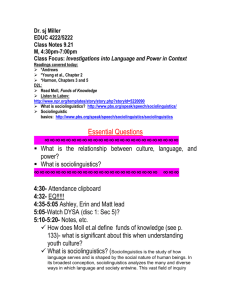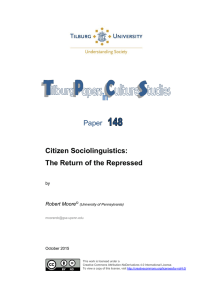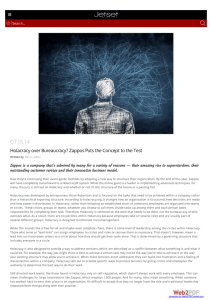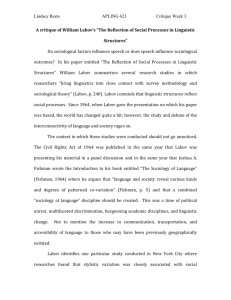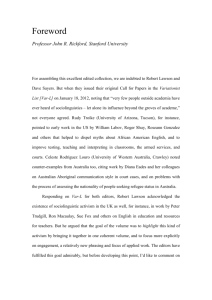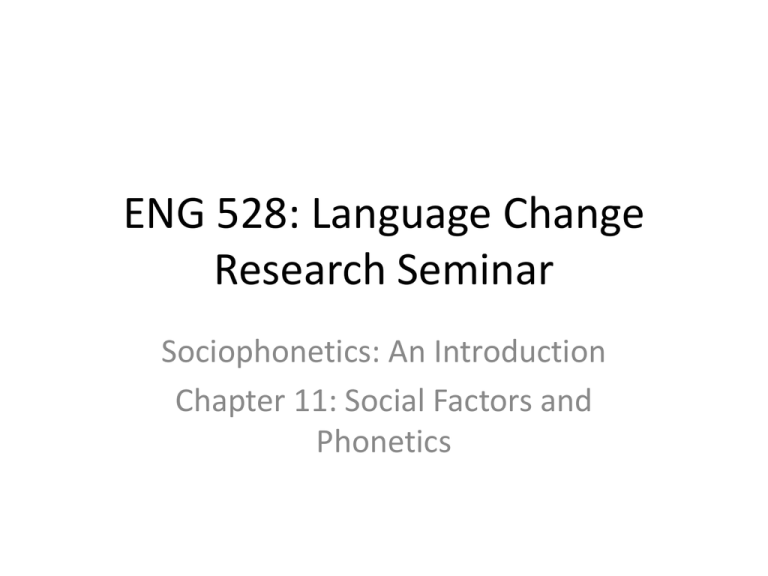
ENG 528: Language Change
Research Seminar
Sociophonetics: An Introduction
Chapter 11: Social Factors and
Phonetics
Contributions from Sociology
• Various ideas that are part of the basic
sociolinguistics lore were adopted from sociology,
such as
Sociometric analysis
Density and multiplexity
Communities of Practice (COPs)
• We’re interested in how these things relate to
phonetics and to cognition
• The medium for that interaction is social
indexing, or indexicality
Quantitative Sociolinguists (1)
• Old-time
sociolinguistics
basically just
determined how
correlated
demographic features
of speakers were with
linguistic features
• Here’s a figure from
Labov (1966)
Quantitative Sociolinguistics (2)
• New independent
variables, such as sex
and ethnicity, were
introduced
• This is from Wolfram
(1969)
Quantitative Sociolinguistics (3)
• Of course, all demographic scales have
problems
• Social class is especially problematic
• In spite of that, some consistent findings
emerged about who leads linguistic change:
Females usually lead males
Lower-middle and upper-working classes
usually lead
Labov’s (1972b) Classification of
Variants
• Indicator: early stage; shows differences
among groups, but no stylistic variation;
“below the level of social awareness”
• Marker: middle stage; shows stylistic
conditioning, indicating some sort of
awareness by speakers
• Stereotype: late stage; people make overt
remarks about the variant; variants that reach
this stage are usually doomed
Speaking Style (1)
• This has been an especially contentious topic
• Labov’s (1966) model was based on “attention
to speech” and depended on formality
• There was some dissatisfaction with the
model; Walt likes to discuss how he found
Labov’s cues for casual vs. formal conversation
to be unreliable
Speaking Style (2)
• Bell (1984) finally
offered an alternative
to attention-tospeech
• This was his audience
design model
• It wasn’t the last
word (anybody
surprised?)
Speaking Style (3)
• The speaker design model was sort of a mirror
image of Bell’s audience design
• Lindblom’s (1990) H&H Theory came from a
completely different angle
• It seems to me that all of these factors should
be seen as part of the picture, not as
competing theories about a single “truth”
Accommodation
• Communication Accommodation Theory is
associated with Howard Giles (e.g., Giles,
Coupland, & Coupland 1991)
• Speakers can shift their speech to become more
like their interlocutors or less like them
• Is this deliberate, subconscious, or both? What’s
your intuition about that?
• Later versions of the theory allow for both an
appropriate behavior component and an identity
projection component
The Speech Community
• Holmes & Meyerhoff (1999):
Members share norms
They behave similarly toward those norms
One’s identity isn’t important for membership
One doesn’t become part of the group for a
purpose
• That’s how Labov defined it, anyhow
• Actually, there’s been a lot of controversy over the
years as to what a speech community is
• Bloomfield (1933) first defined it as all speakers of a
single language, and other people used the phrase as
they saw fit
Social Network Analysis (1)
• Holmes & Meyerhoff (1999):
Shared identifications, not shared norms
Membership determined by contrast with other
groups
One doesn’t become part of the group for a
purpose
• Labov’s (1972a) study of Harlem cliques (Jets, Cobras,
Thunderbirds) was an important early use
• Sociometrics have been a prominent part of it
• Eckert’s study of Livonia, MI, used sociometrics (more
on that study later)
• James & Leslie Milroy’s work in Belfast (e.g., L. Milroy
1987) was key
Social Network Analysis (2)
This was Eckert’s
(2000)
sociometric
analysis for the
girls at “Belten
High”
Density and Multiplexity
• Used by the Milroys
for Belfast
• Density= how many of
one’s associates also
associate with each
other
• Multiplexity= how
many places you
interact with
somebody
High- and low-density
networks
D
I
E
C
A
B
J
H
F
G
Communities of Practice (1)
• Holmes & Meyerhoff (1999):
Shared practices, not shared norms or
identifications
Members decide who belongs to the group
• Members participate in an activity and have to
negotiate and agree on the rules/goals
• Regarding language, members work out the social
meanings of variables
• This is a fairly new approach
Communities of Practice (2)
• Eckert’s work in Livonia was the main impetus
“jocks” and “burnouts”
Jocks were more white-collar-oriented
(participated in school activities) and burnouts
more blue-collar-oriented (not into school
activities), but there were some crossovers in
membership
There were also a lot of “in-betweens”
Burnouts tended to have certain vowel shifts,
including a couple of Northern Cities Shift
ones, to a greater degree
• Other people have tried this approach recently
Communities of Practice (3)
5.5
elderly
(b. 1900-22)
parents
(b. 1947-63)
boys
(b. 1981-82)
nonclique girls
(b. 1981-82)
clique
of 8 girls
(b. 1981-82)
5.0
Z3-Z2 for mean of GOAT nucleus
• It can be hard to link
communities of
practice with specific
linguistic variables
(as in Johnstown)
• You can’t generalize
the results to society
at large—every COP
is unique
4.5
4.0
G02
G14
3.5
G21
G20
G18
3.0
G09
2.5
G05
G26
2.0
3.5
4.0
4.5
5.0
5.5
6.0
6.5
Z2-Z1 for mean of TRAP vowel
7.0
7.5
Individual Variation
• In sociolinguistics, “the individual is often anywhere but
in the center of interest in practice” (Johnstone 1996)
• Labov has put the emphasis on group patterns and group
identities, and most other sociolinguists have followed
suit
• Individual variation for phonetic variables is probably
ubiquitous but is hard to prove
• Ironically, Labov is the one who’s done the most to pin it
down—when he looked for the leaders of sound changes
• For dense, multiplex networks, he found that social
leaders were the ones who pushed sound changes the
farthest (but it didn’t work that way in looser networks)
Cognitive Sociolinguistics (1)
• This is a new movement
• Mostly based in Europe
• Grows out of cognitive linguistics, which is a
longer-established tradition (identified with
George Lakoff)
• Discourse and pragmatics have been the main
foci
• Pronunciation has gotten some attention,
though
Cognitive Sociolinguistics (2)
• The important phrase is receptive competence
• People associate linguistic variants with social
groups, larger categories of people, or speaking
styles
• This association is very often subconscious
• As a result, experimentation is needed to get at it
• (“Perceptual Dialectology,” or “Folk Dialectology,”
associated with Dennis Preston, mainly gets at
stereotypes, which isn’t enough)
Questions for Discussion
1. Attention to speech, audience design, speaker design,
and H&H may all be factors that contribute to style
shifting. How can you distinguish their effects in a
study? To what degree do their effects overlap?
2. Design a perception experiment that taps subjects’
subliminal cognitive associations between some
linguistic variant and knowledge of what groups use
that variant. What differences in the experiments are
needed to get at associations with (a) broad
demographic groups, (b) speech communities, (c)
networks, (d) communities of practice, and (e)
individuals?
References
• Bell, Allan. 1984. Language style as audience design. Language in Society
13:145-204.
• Bloomfield, Leonard. 1933. Language. New York: Holt, Rinehart, and
Winston.
• Eckert, Penelope. 2000. Linguistic Variation as Social Practice: The
Linguistic Construction of Identity in Belten High. Malden, MA: Blackwell.
• Giles, Howard, Nikolas Coupland, and Justine Coupland. 1991.
Accommodation theory: Communication, context, and consequence. In
Howard Giles, Nikolas Coupland, and Justine Coupland (eds.), Contexts of
Accommodation: Developments in Applied Sociolinguistics, 1-68.
Cambridge, UK/New York: Cambridge University Press.
• Holmes, Janet, and Miriam Meyerhoff. 1999. The community of practice:
Theories and methodologies in language and gender research. Language
in Society 28:173-83.
• Johnstone, Barbara. 1996. The Linguistic Individual: Self-Expression in
Language and Linguistics. Oxford/New York: Oxford University Press.
References (continued)
• Labov, William. 1966. The Social Stratification of English in New York City.
Washington, DC: Center for Applied Linguistics.
• Labov, William. 1972a. Language in the Inner City: Studies in the Black
English Vernacular. Philadelphia: University of Pennsylvania Press.
• Labov, William. 1972b. Sociolinguistic Patterns. Conduct and
Communication 4. Philadelphia: University of Pennsylvania Press.
• Lindblom, Björn. 1990. Explaining phonetic variation: A sketch of the H&H
theory. In William J. Hardcastle and Alain Marchal (eds.), Speech
Production and Speech Modelling, 403-39. Dordrecht: Kluwer.
• Milroy, Lesley. 1987. Language and Social Networks. 2nd ed. Language in
Society series 2. Oxford, UK/Malden, MA: Blackwell.
• Wolfram, Walter A. 1969. A Sociolinguistic Description of Detroit Negro
Speech. Urban language series 5. Washington, DC: Center for Applied
Linguistics.

